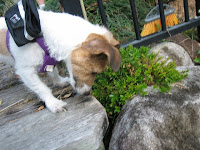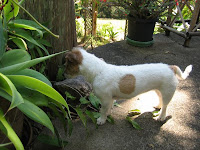This post is a jumble, just to get me back in the swing. Lots has been happening around here since I last visited...some good things (e.g. J's wedding which I'll talk about elsewhere), and some (e.g. septic problems) not so good. The problems are gradually righting themselves, with quite a lot of help from me and various tradesmen (no fewer than five different sets of contractors got stuck into the sewerage problem – some literally so!) First, a plumber 'looked into' the problem. Next, a couple of incredibly cheerful young men pumped out the holding tank. And I was reminded what a pleasure it is (and how unusual) to find young adult male strangers who are not only polite, but actually friendly to a couple of old wrinklies like us. A's Blue Care carer was still here when these boys arrived. One of the guys had had a bad motorbike accident a few years ago. During his recovery Blue Care nurses had helped him a lot, and he was particularly keen to express his appreciation of that. Maybe that early brush with near-death left a big impression, but for whatever reason he really was an unusually happy-go-lucky young man, given the rather unpleasant nature of his work.
 Next came a rather morose giant who sent a camera down the outflow drain to check for blockages there. Then another plumber came in to interpret all the findings. This guy, provided by the lovely people at Home Assist, who have helped to provide various special facilities that Allen has needed, concluded the old trench could be rehabilitated. Not only does this save us thousands of dollars, it also means we don't have to undertake trench work that would also almost certainly attract the attention of a troublesome neighbour, whose complaints to Council could result in our having to bankroll an even more expensive solution. So instead of digging a new trench, a pair of young men in very short shorts arrived with a big truck-mounted pump, and did unspeakable things to the old trench using high-pressure jets of water. Finally, we went out and bought a new water-wise front-loading washing machine that will not strain the drainage trench as much as the 22-year-old top-loading monster did. And as a result of all that, we hope our waste management system is once again functional, though only time will tell.
Next came a rather morose giant who sent a camera down the outflow drain to check for blockages there. Then another plumber came in to interpret all the findings. This guy, provided by the lovely people at Home Assist, who have helped to provide various special facilities that Allen has needed, concluded the old trench could be rehabilitated. Not only does this save us thousands of dollars, it also means we don't have to undertake trench work that would also almost certainly attract the attention of a troublesome neighbour, whose complaints to Council could result in our having to bankroll an even more expensive solution. So instead of digging a new trench, a pair of young men in very short shorts arrived with a big truck-mounted pump, and did unspeakable things to the old trench using high-pressure jets of water. Finally, we went out and bought a new water-wise front-loading washing machine that will not strain the drainage trench as much as the 22-year-old top-loading monster did. And as a result of all that, we hope our waste management system is once again functional, though only time will tell. Remembering this week's contacts with tradespeople reminds me: I must ask the library to find a copy of Shop Class as Soulcraft: An Inquiry Into the Value of Work, by Matthew B Crawford. It's reviewed in this week's Weekend Australian, and sounds tantalising. "Crawford's aim is to extol the worth of skilled labour, the practice of a trade....The work they [tradesmen] do requires 'practical wisdom'....Above all, their work genuinely benefits society because it produces tangible, readily assessable results." How many of us public servants have occasionally been tempted to throw in careers in "the most ghostly kinds of work", by which Crawford means "phony, ill-defined, ephemeral" work! How many have thought, sometimes very seriously, about tossing it all in and retraining in something like landscape gardening or cooking! I certainly have. At such times, we probably felt we were doing what reviewer Roy Williams in this article describes as "jobs that don't require doing anything extremely well", in what author Crawford calls 'the world of white-collar bullshit". Coincidentally, last night I began reading Adrift on the Nile by Naguib Mahfouz and in the first paragraph I came across this: "On the shelves the files enjoy an easeful death. How diverting they must find the civil servant at work, carrying out, with utterly serious mien, utterly trivial tasks." I was immediately propelled back in time into my literally and figuratively grey office at Education Queensland.
 Well, pumping out septic tanks probably isn't the kind of "skilled labour" Crawford had in mind in writing that book. But if my contact this week with tradespeople provided that one embodiment of Crawford's hypothesis, "that most of the people who perform these jobs are personally fulfilled", another guy I dealt with followed a life path in a totally different direction. He is an ex-builder who is currently erecting a new balustrade and mini-pergola atop our 40,000 litre concrete rainwater tank (that's a 10,000-gallon storage tank, for US friends). The only reason he is doing this work for me is that he doesn't have enough work in the field that he left building to pursue! Obviously unfulfilled as a tradesman and not content with performing "skilled labour", he retrained as a counsellor. But however good he may be in his new role (and I suspect from the interesting discussions we've had during coffee breaks he may be quite good at it, and of course he'd bring to the table practical experience of working in the 'real world'), he hasn't got sufficient academic qualifications to enable him to benefit from the newly introduced Medicare subsidies available for consultations with fully qualified psychologists. Apparently, counselling work, however fulfilling, just isn't paying the bills. So he's resorting to occasional little projects like my balustrade to do that. Personally, if I had to choose between having sufficient skills to erect a nice cypress-pine construction and the ability to listen to other people's problems with the hope of helping them find resolution, right now, in my 60s, I'd definitely opt for the woodworking skills. Maybe in my 20s or 30s, when idealism wielded more power over my will, I might have chosen differently. (Incidentally, the balustrade is not yet finished; more photos will follow later.)
Well, pumping out septic tanks probably isn't the kind of "skilled labour" Crawford had in mind in writing that book. But if my contact this week with tradespeople provided that one embodiment of Crawford's hypothesis, "that most of the people who perform these jobs are personally fulfilled", another guy I dealt with followed a life path in a totally different direction. He is an ex-builder who is currently erecting a new balustrade and mini-pergola atop our 40,000 litre concrete rainwater tank (that's a 10,000-gallon storage tank, for US friends). The only reason he is doing this work for me is that he doesn't have enough work in the field that he left building to pursue! Obviously unfulfilled as a tradesman and not content with performing "skilled labour", he retrained as a counsellor. But however good he may be in his new role (and I suspect from the interesting discussions we've had during coffee breaks he may be quite good at it, and of course he'd bring to the table practical experience of working in the 'real world'), he hasn't got sufficient academic qualifications to enable him to benefit from the newly introduced Medicare subsidies available for consultations with fully qualified psychologists. Apparently, counselling work, however fulfilling, just isn't paying the bills. So he's resorting to occasional little projects like my balustrade to do that. Personally, if I had to choose between having sufficient skills to erect a nice cypress-pine construction and the ability to listen to other people's problems with the hope of helping them find resolution, right now, in my 60s, I'd definitely opt for the woodworking skills. Maybe in my 20s or 30s, when idealism wielded more power over my will, I might have chosen differently. (Incidentally, the balustrade is not yet finished; more photos will follow later.) Be all of that as it may, I was talking about what's been going on around here. And the other recent achievement is the laying down of a new path from the bottom of the stairway over to the pool on the left, and down toward the vegetable garden level on the right. My post of 4 September 2009, “Sharing the load”, described preparations for this paving work. And about 10 days ago, P (who has mowed our paddock for more than 10 years) came and laid the pavers. And as we had some left over, he also made a 'ramp' off the back verandah, to help Allen get around that part of the garden a bit more safely.
Be all of that as it may, I was talking about what's been going on around here. And the other recent achievement is the laying down of a new path from the bottom of the stairway over to the pool on the left, and down toward the vegetable garden level on the right. My post of 4 September 2009, “Sharing the load”, described preparations for this paving work. And about 10 days ago, P (who has mowed our paddock for more than 10 years) came and laid the pavers. And as we had some left over, he also made a 'ramp' off the back verandah, to help Allen get around that part of the garden a bit more safely. And to close, here's a photo of this week's visitors – a pair of white cockatoos who have made the contents
And to close, here's a photo of this week's visitors – a pair of white cockatoos who have made the contents of this particular feeder tray a part of their daily menu. I had to move the bird feeders off to either side of the water tank because of the work going on to build a new balustrade. But now I've decided to keep the feeders there, among the bushes and trees, so visitors' droppings are less likely to mess up our lovely new cypress timberwork. And so this post ends where it began – with waste management.






















